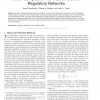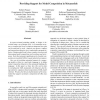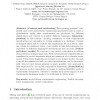116
click to vote
JOT
2010
14 years 7 months ago
2010
Model composition is a crucial activity in Model Driven Engineering (MDE). It is particularly useful when adopting a multi-modeling approach to analyze and design software systems...
91
Voted
TCBB
2010
14 years 10 months ago
2010
—Models of regulatory networks become more difficult to construct and understand as they grow in size and complexity. Large models are usually built up from smaller models, repre...
110
Voted
WSC
2007
15 years 2 months ago
2007
Two basic approaches to simulation model composition can be distinguished, depending on whether the unit of composition is a model specification according to a certain modeling f...
90
Voted
ECMDAFA
2006
Springer
15 years 4 months ago
2006
Springer
There is little agreement on terminology in model composition, and even less on key characteristics of a model composition solution. We present three composition frameworks: the At...
92
Voted
ECMDAFA
2007
Springer
15 years 6 months ago
2007
Springer
Due to the increased complexity of software development projects more and more systems are described by models. The sheer size makes it impractical to describe these systems by a s...
96
Voted
EDOC
2007
IEEE
15 years 6 months ago
2007
IEEE
In aspect-oriented modeling (AOM), a design is described using a set of design views. It is sometimes necessary to compose the views to obtain an integrated view that can be analy...
130
Voted
SOCO
2009
Springer
15 years 7 months ago
2009
Springer
Model composition helps designers managing complexities by modeling different system views separately, and later compose them into an integrated model. In the past years, researche...
98
Voted
REFSQ
2009
Springer
15 years 7 months ago
2009
Springer
Abstract. [Context and motivation] Ever-growing systems’ complexity and novel requirements engineering approaches such as reuse or globalization imply that requirements are produ...
104
Voted
ICMT
2009
Springer
15 years 7 months ago
2009
Springer
In software product line engineering, feature composition generates software tailored to specific requirements from a common set of artifacts. Superimposition is a technique to me...



